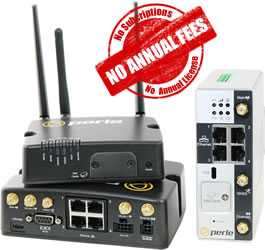
Unraveling the Wireless Future: What is a Wireless WAN (WWAN)?
By Julie McDanielVice President Marketing
May 22, 2024
To understand a Wireless Wide Area Network (WWAN), we must take a step back and look at the roles and significance of the LAN, WLAN, and WAN in corporate enterprise network infrastructures.
Imagine your office building with data flowing to different floors or adjacent buildings. This is the Local Area Network (LAN). Efficient, high-speed, and confined within a limited geography, the LAN acts as the robust nervous system for an enterprise, allowing for real-time collaboration, seamless data transfers, and shared access to resources such as file servers, databases, and applications. Here, employees connect their devices to a network of Ethernet cables to collaborate on projects, share large files, or even print documents from shared printers - all attributes that enhance productivity and drive corporate efficiency.
Yet, as business landscapes evolve, the need for mobility and flexibility surges, paving the way for the Wireless Local Area Network (WLAN). Rather than being tied down by physical cables, WLANs use wireless Wi-Fi signals to connect devices within the same local area, liberating workstations from their wired anchors and paving the way for mobile device integration — think laptops, smartphones, tablets. This wireless symphony empowers businesses to embrace a mobile and dynamic workspace layout while maintaining the core attributes of a secure LAN environment.
To extend inter-office communication to branch locations across cities or continents, enterprise network infrastructures turn to the Wide Area Network (WAN). It is like the intricate web of highways that extends the reachability of LANs through leased telecommunication lines, generally fiber-optic, ensuring reliable and synchronous communication over vast distances. With the WAN's help, geographically dispersed enterprise locations interconnect and communicate synchronously, extending a company's reach and ability to operate as a unified entity. Consider the WAN as the bridge helping you coordinate with a colleague from another city, access company-wide systems hosted in different locations, or execute remote backup and disaster recovery operations.
However, the rise of cellular-enabled devices and the need for constant global connectivity have paved the way for Wireless Wide Area Networks (WWANs). Extending far beyond physical cabling, WWANs leverage cellular technology to connect devices and wirelessly transmit data over extensive areas, akin to how your mobile phone connects to the internet without Wi-Fi. This mobility allows remote employees, traveling executives, and field operators to maintain their connection to the corporate network, enhancing business agility and workforce productivity.
So, if we were to define Wireless Wide Area Networks (WWANs) in one phrase, it would be "the wireless network that stretches over vast distances using cellular broadband services." In other words, WWANs capitalize on cellular frequency bands to extend the reach of traditional Wide Area Networks (WANs) beyond the confines of physical fiber optic or other cable connections.
So, How Do WWANs Work?
WWANs rely on cellular network technologies to create and maintain their connections. Data is transferred through cellular towers strategically placed to ensure seamless communication within a specific area. Devices access the WWAN using their built-in wireless modems, which depend on SIM cards for identification and authentication on the network.
Cellular Routers are used in WWAN networks to provide the shortest data communication path over long distances using routing tables. A SIM card, encoded with a unique identifier, allows the router to be recognized by the network provider before it can securely and quickly transmit data over the wireless network.
Does WWAN use LTE or 5G?
With numerous technological advancements over the years, WWANs have experienced quite an evolution. They have embraced different generations of cellular technology, starting with the humble 2G (second generation). While 2G was primarily used for voice and SMS capabilities, the introduction of 3G and 4G LTE enabled higher data transfer rates, giving way to multiple data-hungry applications like video streaming, high-res images, and video conferencing.
Now, 5G has pushed the boundaries of wireless technology even further. With exponentially higher speeds, lower latency, and superior connectivity, 5G has elevated WWANs to new heights with business applications that we are only beginning to imagine.
Why Should We Care About WWANs?
In a world where mobile technologies dominate the business landscape, WWANs have emerged as a game-changing shift. The sheer versatility they offer has led organizations across the globe to adopt WWANs as the backbone of their enterprise network infrastructures.
Compared to their wired counterparts, WWANs provide unmatched freedom when connecting devices beyond the confines of physical office spaces. With WWANs, employees can stay constantly connected to a business's network, regardless of location, giving rise to a truly global workplace.
Moreover, WWANs make it significantly easier for organizations to expand their reach, streamline digital transformation initiatives, and access critical real-time data, irrespective of geographical boundaries.
In a nutshell, Wireless Wide Area Networks have revolutionized how we perceive and interact with enterprise network infrastructures. Offering seamless connectivity across vast distances, unparalleled freedom, and unmatched adaptability, WWANs are shaping the course of our increasingly interconnected and mobile future.
Navigating the Present and the Future
Currently, we are navigating through a tech landscape where WWANs have become the backbone for digital transformation initiatives within businesses. The increasing need for IoT connectivity and the swelling demand for real-time data access have further propelled the adoption of WWANs.
Looking ahead, the evolution from wired to wireless WANs is set to continue, with connected environments like smart cities and advanced IoT ecosystems becoming commonplace.
Our network infrastructure has come a long way from its humble wired beginnings. Having weathered the tides of technological change, it now sails in the wireless seas, charting new avenues for enhanced connectivity, efficiency, and growth. As we journey forward, one thing is certain: our exploration of this vast, interconnected digital universe has only just begun.



